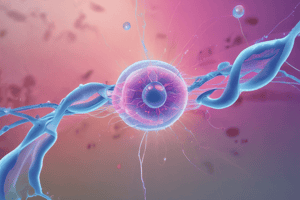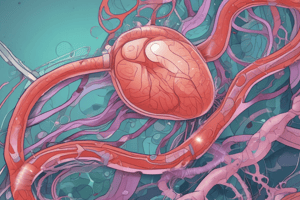Podcast
Questions and Answers
What is the process by which an egg is released from the ovary in the female reproductive system?
What is the process by which an egg is released from the ovary in the female reproductive system?
- Oogenesis
- Ovulation (correct)
- Menstruation
- Fertilization
What is the process by which the genetic information encoded in DNA is used to synthesize a protein?
What is the process by which the genetic information encoded in DNA is used to synthesize a protein?
- Protein Synthesis (correct)
- Transcription
- Gene Expression
- Translation
What is the term for the study of the inheritance of traits from one generation to the next?
What is the term for the study of the inheritance of traits from one generation to the next?
- Genetics (correct)
- Epigenetics
- Genomics
- Molecular Biology
What is the term for the process by which sperm cells are produced in the male reproductive system?
What is the term for the process by which sperm cells are produced in the male reproductive system?
What is the term for the process by which a sperm fertilizes an egg, resulting in the formation of a zygote?
What is the term for the process by which a sperm fertilizes an egg, resulting in the formation of a zygote?
Study Notes
Reproductive System
- The male reproductive system consists of testes, epididymis, vas deferens, prostate gland, urethra, and penis.
- Functions of the male reproductive system include producing hormones and sperm, and transporting and storing sperm.
- The female reproductive system consists of ovaries, oviducts, uterus, cervix, and vagina.
- Functions of the female reproductive system include producing hormones and eggs, and supporting fertilization and embryonic development.
Sex Hormones
- Androgens (testosterone) and estrogens (estradiol) are the primary sex hormones in males and females, respectively.
- Sex hormones regulate the development of reproductive organs, secondary sex characteristics, and the reproductive cycle.
Physiology of Menstruation
- The menstrual cycle is a hormonal cycle that prepares the uterus for a fertilized egg.
- The cycle consists of the follicular phase, ovulation, and the luteal phase.
- During menstruation, the uterus sheds its lining, and a new cycle begins.
Fertilization
- Fertilization occurs when a sperm penetrates the outer layer of an egg, resulting in a zygote.
- The zygote undergoes several cell divisions, forming a blastocyst, which implants in the uterus.
Spermatogenesis and Oogenesis
- Spermatogenesis is the process of sperm production, which occurs in the seminiferous tubules of the testes.
- Oogenesis is the process of egg production, which occurs in the ovaries.
- Both processes involve meiosis, resulting in haploid gametes.
Pregnancy and Parturition
- Pregnancy is the period of gestation, during which the fertilized egg develops into a fetus.
- Parturition is the process of childbirth, which involves uterine contractions and cervical dilation.
Introduction to Genetics
Chromosomes, Genes, and DNA
- Chromosomes are thread-like structures composed of DNA and proteins, carrying genetic information.
- Genes are the basic units of heredity, made up of DNA sequences that code for proteins.
- DNA (deoxyribonucleic acid) is a double-stranded molecule containing the genetic instructions for an organism.
Protein Synthesis
- Protein synthesis is the process of translating mRNA sequences into amino acid sequences.
- It involves transcription, translation, and post-translational modifications.
Genetic Pattern of Inheritance
- The genetic pattern of inheritance follows Mendel's laws of inheritance, including the law of segregation and the law of independent assortment.
- Inheritance patterns can be predicted using Punnett squares and probability calculations.
Studying That Suits You
Use AI to generate personalized quizzes and flashcards to suit your learning preferences.
Description
This quiz covers the anatomy and functions of the male and female reproductive systems, including sex hormones, menstruation, fertilization, and genetics fundamentals like chromosomes, genes, and DNA.




